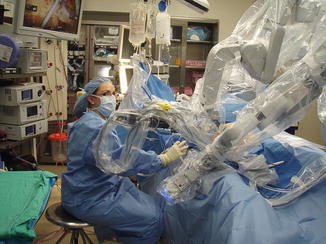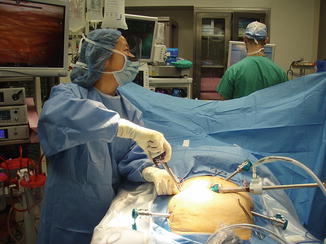The role of the bedside assistant
• Setup of the room and draping of the robot
• Patient positioning
• Robot docking
• Provide retraction, suction, and irrigation or apply a stapler, energy device, or clip
• Instrument exchange
• Maintain a clean camera and change the angle of the camera as needed
• Assist with adjustment of robot arms
• Perform emergency undocking maneuvers if needed
Table 9.2
Qualities to look for when choosing a bedside assistant
Qualities of a good bedside assistant |
|---|
• Maintains constant communication with the console surgeon |
• Knows the steps of the procedure |
• Has knowledge of relevant anatomy |
• Understands the instruments and has technical knowledge of the robot system |
• Understands the limitations of the robot |
Intuitive has so far came out with three da Vinci robot prototypes, each more advanced than the previous model. With the introduction of robotic suction, energy device, and stapler, the role of the assistant has evolved as well. However, not every hospital has purchased the newer components, and essential parts of surgery can still be done with the older equipment operated by the assistant.
The goal of this chapter is to define the role of the bedside surgeon and to aid surgeons who are starting out on the robot with how to use the bedside assistant more efficiently, facilitating quicker and safer surgery, leading to fewer conversions, and preventing “wear and tear” on the primary surgeon and assistant.
9.2 Preoperative Preparation
The bedside assistant should be involved in preoperative preparation of the patient and the operating suite. We usually check the patient’s BMI, other comorbidities, and pre-op status including any dermatologic or neurologic problems. When operating on the elderly or patients with severe arthritis, great care should be taken when positioning them in stir-ups, and more padding should be used for the bony prominences and around the joints. Prior to a patient coming to the operating room, the bedside assistant should check with the OR staff for any concerns with the equipment, draping of the robot, or calibration of the camera.
9.2.1 Patient Positioning
Patient positioning is critical when performing colorectal surgery. A well-defined operative setup and plan can improve efficiency and patient safety when performing robotic colon resection. With robotic surgery, the surgeon is faced with unique challenges. The patient’s position cannot be changed after the robot is docked. At times, patient stays in the same position putting pressure on the same places for a long time. Incorrect positioning can lead to pressure ulcers, nerve damage, and other complications. Brachial plexus nerve injuries are discovered after approximately 0.16 % of advanced laparoscopic procedures, and the risk is probably higher for robotic surgery [6].
To minimize the risk of brachial plexus injuries during robotic surgery, the arms should be tucked at the side of the patient whenever possible. Braces should be avoided. Either a moldable beanbag or nonskid mattress should be used. We use The Pink Pad-Pigazzi Positioning System (Xodus Medical Inc.) to prevent the patient from sliding during surgery and to act as a safeguard to prevent injury by conforming to the patient body and dispersing pressure (see Fig. 9.1). It is primarily the responsibility of the assistant to ensure correct patient positioning, padding, and securing. Once positioned on the Pink Pad, it is very difficult to move the patient. Thus, the position of the mattress should be checked prior to patient’s laying down on it, and the patient’s positioning should be adjusted when the patient is not anesthetized.


Fig. 9.1
Standard patient lithotomy positioning using The Pink Pad-Pigazzi Positioning System (Xodus Medical Inc.) for left colectomy or pelvic dissection
During surgery, the bedside assistant is responsible for checking that the patient has not shifted, and the arms of the robot do not touch the patient to prevent injury. The primary surgeon is neither aware of the positioning of the arms in relation to the patient, since there are no tactile clues, nor has the visual awareness of what is occurring outside the console (see Fig. 9.2).


Fig. 9.2
The console surgeon is immersed in the operation, while the bedside surgeon must ensure the safe interaction between the robot and the patient
Once the patient has been optimally positioned and the robot is docked, the bedside assistant takes position by the patient. For a left colon or pelvic procedure, the bedside assistant typically stands on the patient’s right side. During a right hemicolectomy, the assistant stands on the patient’s left side. We provide the bedside assistant with a sitting stool to maximize comfort and find that the quality of laparoscopic assistance is unaffected (Fig. 9.3).


Fig. 9.3
The bedside assistant is sitting comfortably while providing laparoscopic assistance, which promotes endurance throughout the operation. Note the safe distance between the robot and the assistant
9.2.2 Port Placement
Port placement is essential to successful surgery. Each patient has a specific body habitus necessitating port positioning to be individualized. Ports placed too close to each other will hamper movement and cause clash of instruments, whereas ports placed too far from the site of surgery may not allow the instruments to reach the operative site. The bedside assistant is often the one placing the ports (Fig. 9.4).









